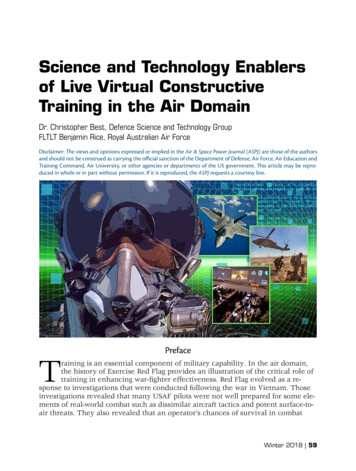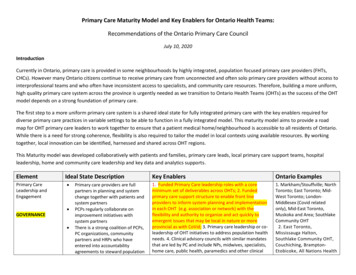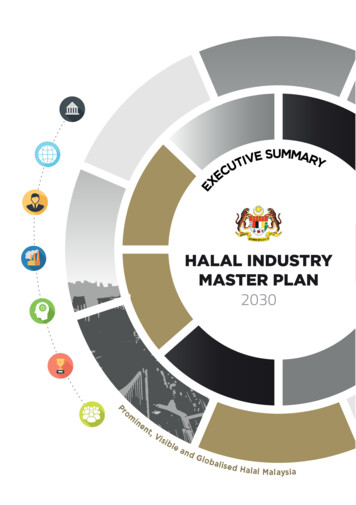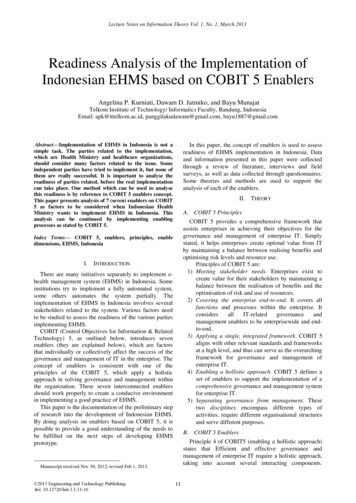
Transcription
Science and Technology Enablersof Live Virtual ConstructiveTraining in the Air DomainDr. Christopher Best, Defence Science and Technology GroupFLTLT Benjamin Rice, Royal Australian Air ForceDisclaimer: The views and opinions expressed or implied in the Air & Space Power Journal (ASPJ) are those of the authorsand should not be construed as carrying the official sanction of the Department of Defense, Air Force, Air Education andTraining Command, Air University, or other agencies or departments of the US government. This article may be repro duced in whole or in part without permission. If it is reproduced, the ASPJ requests a courtesy line.TPrefaceraining is an essential component of military capability. In the air domain,the history of Exercise Red Flag provides an illustration of the critical role oftraining in enhancing war-fighter effectiveness. Red Flag evolved as a re sponse to investigations that were conducted following the war in Vietnam. Thoseinvestigations revealed that many USAF pilots were not well prepared for some ele ments of real-world combat such as dissimilar aircraft tactics and potent surface-to air threats. They also revealed that an operator’s chances of survival in combatWinter 2018 59
Best & Ricesubstantially grew after they had participated in about 10 missions characterizedby the presence of such threats. Red Flag was conceived as a means of providingoperators with their first realistic combat missions in a training environment thatwas relatively safe but also representative of real-world conditions. Since its incep tion, Red Flag has become known as the world’s premier air-combat training eventand the benefits of the lessons learned during Red Flag have been realized in com bat operations.1Live-flying exercises such as Red Flag can provide excellent learning opportuni ties. However, they are expensive and logistically challenging. Environmental, regu latory, and safety constraints also place limitations on the kinds of learning experi ences that can be provided during live training. Simulation provides a means bywhich to address some of these shortcomings. Since the 1990s, significant programsof research and development across coalition nations demonstrated that similartraining benefits can be obtained by connecting distributed simulation systems.2Large networks of simulators are now used regularly to provide complex and realis tic training for air combat. Recently, attention has turned to the possibility of inte grating live aircraft into simulation networks. This has led to a great deal of discus sion about the importance, potential benefits, and underpinning science andtechnology of live-virtual-constructive (LVC) integration.IntroductionLVC integration refers to the use of three different kinds of systems to generateoperationally realistic scenarios for training and experimentation. The live compo nent of an LVC federation typically includes operational platforms, real missionsystems, and personnel who are trained in their use. The virtual component in cludes similarly trained personnel and human-in-the-loop simulation systems thatrepresent the capabilities and interfaces of operational systems in a manner thataffords real-time interaction. These are often referred to simply as simulators. Theconstructive components of an LVC federation are those that represent the capabili ties and behavior of operational platforms, systems, personnel, or organizationalunits as computer-generated entities whose actions are determined by predefinedscripts, rule sets, or adaptive behavioral models.3With respect to training, what distinguishes LVC from concepts such as Distrib uted Mission Training, Distributed Mission Operations, and Mission Trainingthrough Distributed Simulation is a specific emphasis on the integration of live plat forms.4 The use of integrated live, virtual, and constructive systems for training isexpected to provide a range of benefits, such as: (1) enhancing the training out comes obtained from live flying, (2) enabling the generation of scenarios of suffi cient scale and complexity to exercise fifth-generation capabilities fully,5 (3) aug menting existing training ranges to provide electronic and cyber warfare effects, (4)better supporting the large footprints of modern sensors, networks, and weapons,and (5) allowing new platforms to be exercised in a secure environment so as not toreveal the sensitive aspects of their capability.660 Air & Space Power Journal
LVC Science and TechnologyDespite the emphasis that is typically placed on the integration of live platformsin LVC, we believe there are several reasons to question the specific utility of thelive component. For example, while it is almost certainly true that some skills arebest learned during live training (e.g., those relating to the physical aspects of highG fighter maneuvers), we are not aware of any analysis demonstrating that the aug mentation of live training with virtual and constructive threats or electronic, andcyber-warfare effects, for example, increases the effectiveness or efficiency of train ing for those particular skills to an extent that would justify the significant invest ment that would be required. Also, as the scale and complexity of exercises grow, sodo the constraints on live training associated with the requirement to maintain safeaircraft separation. This can lead to artificialities in live training. Furthermore, it isnot clear how any solution that would enable the generation of scenarios of suffi cient scale and complexity to properly exercise fifth-generation capabilities in thelive environment would not also present problems associated with revealing sensi tive aspects of those capabilities. And finally, if representing cyber and electronicwarfare effects and exerting influence over large geographic areas are key objectivesof training, it does not necessarily follow that the integration of live platforms pro vides a better solution than improved virtual and constructive training capabilities.In light of these issues, we propose a reconsideration of the emphasis that hastypically been placed on live integration in LVC training for the air domain. Specifi cally, we propose that the benefits of integrating live, virtual, and constructive sys tems may not arise as a direct result of the inclusion of live platforms or the aug mentation of live training per se, but rather from the additional scope that LVCintegration could afford trainers to represent friendly and threat entities and effectsusing whichever kinds of systems are most useful and practical, given their desiredoutcomes and the resources they have at their immediate disposal.7 This flexibilityis important not just because it could enable trainers to exercise their preferences,but also because in situations characterized by resource constraints or high opera tional tempo, the ability to choose between live, virtual, and constructive systemscould mean the difference between being able to provide high-end training and notbeing able to do so. This article next examines the implications of this perspectivefor LVC capability development.The Role of Science and TechnologyWhile some of the components required for LVC integration in the air domainalready exist, a great deal of development will be needed to make the most of thecapability.8 Science and technology have a critical role in helping the military torealize the potential of emerging capabilities and concepts of operation such asLVC integration.9 To effectively align science and technology support it is neces sary to have some concept of how LVC technologies are likely to be used as well ashow, in combination with other concepts or technologies, they could lead to newopportunities.10The conceptualization of LVC integration as a means of affording greater flexibil ity in the design and delivery of training may assist in: (1) clarifying the role andWinter 2018 61
Best & Riceimportance of live integration, (2) defining a developmental trajectory for the capa bility, and (3) aligning science and technology support to capability development.This concept suggests that the goal of LVC capability development should be to pro vide a broad range of options for representing friendly and threat entities and ef fects, thereby enabling trainers to exercise maximum flexibility in tailoring the de sign and execution of training events to desired outcomes and available resources.In turn, this goal suggests two roles for science and technology, which are to (1) ex pand the range of options that are available, and (2) help inform the choices train ers make about the use of those options.In this article, we explore the consequences of this conceptualization with a spe cific focus on LVC training in the air domain and with consideration for how thecombination of a range of technologies could support transformations in trainingcapability. We do this by drawing out the details of three potential use cases for LVCintegration and considering the science and technology challenges each presents.Each use case builds on those preceding it in terms of the degree of flexibility it of fers to trainers. These use cases are not intended to be exhaustive or mutually ex clusive but by highlighting the need for a significant amount of research and devel opment across a wide variety of disciplines, we believe they help to clarify therequirements for science and technology support and could serve as the foundationfor more detailed planning.Use Case One: Large-Scale LVCThe importance and likely impact of LVC integration for training are oftenthought of in terms of broadly defined future use cases that serve to illustrate how amature capability could be employed. One such use case that we will refer to aslarge-scale LVC provides a suitable starting point because it represents a straightfor ward extension of existing training practices. We use the term large-scale LVC to re fer to the use of secure, wide-area networks to connect many diverse,geographically-distributed LVC systems to bring together large numbers of person nel to participate in complex exercise scenarios.There is little doubt of the value of preparing personnel to operate as membersof a large, integrated force in complex mission environments.11 Existing large-forceemployment exercises such as Pitch Black, Talisman Sabre, and Red Flag can pro vide valuable learning experiences. It is possible that integrating LVC elementsinto large exercises could enable these experiences to be delivered just as effec tively, while also reducing logistical costs and enabling more complex scenarios tobe generated than would be possible using live assets alone. However, even thisstraightforward vision of LVC integration presents many science and technologychallenges.The Science and Technology Challenges of Large-Scale LVCLarge-scale LVC represents an extension of live exercise practices that takes ad vantage of emerging connectivity between live, virtual, and constructive systems.62 Air & Space Power Journal
LVC Science and TechnologyAlthough connectivity between virtual and constructive systems is relatively wellunderstood, many fundamental science and technology challenges remain in rela tion to establishing common, interoperable, and verifiable models of the full rangeof modern platforms, sensors, and weapons as well as effects such as weather andcyber and electronic warfare. LVC integration presents a particularly difficult chal lenge in relation to the verification and validation of such models. In part this is be cause interactions between systems can lead to a vast number of possible overallsystem states and the composition of LVC federations is unlikely to be stable overextended periods of time.12 Nevertheless, accurate modelling of friendly and adver sary systems, effects, and their interactions will be a critical driver of the realism ofLVC training environments and therefore development in this area represents animportant science and technology challenge.Significant science and technology challenges also exist in relation to achievingsecure and reliable integration of live platforms. To link live platforms with virtualand constructive systems in the air domain, infrastructure is required both on theaircraft and on the ground. Current solutions such as the P5 Combat Training Sys tem (Cubic Global Defence) involve the use of aircraft-mounted pods which enablethe transmission and receipt of real-time air-combat parameters through encryptedcommunication channels. While these devices provide a baseline capability, meth ods for handling data at multiple levels of classification, dealing with bandwidthand range limitations, and integrating synthetic data with live aircraft systems areyet to be well established.The challenges related to classification may prove to be particularly difficult inthe context of large-scale LVC because they involve issues of policy as well as tech nology. Integrating platforms at multiple levels of classification requires so-calledcross-domain solutions to guarantee that sensitive information is not passed inap propriately between platforms of relatively high and relatively low classification.Some products of this general kind are currently available. However, existing sys tems can be laborious to configure and manage and they typically operate by sim ply blocking data. Data diodes provide an example of this approach. These devicesenforce a one-way flow of information; usually from systems at a low level of clas sification (the “low side”) to systems at a high level of classification (the “highside”). While the simplicity of this approach is appealing, it introduces something ofa paradox in relation to large-scale training. By ensuring that participants on thelow side see little or nothing of what takes place on the high side, sensitive informa tion can be protected. However, the extent to which such groups can be said to betraining together, or that valid lessons can be expected to emerge from their interac tions, is questionable. Methods for passing useful but declassified information to thelow side have been trialed. However, much remains to be done to clarify how suchapproaches should be managed within exercises from the perspective of balancingsecurity, realism, and training outcomes.Development is also required in relation to safely and effectively integrating sim ulated data into live aircraft systems. Since the mission systems of most live aircraftdo not enable the simulation of effects relating to virtual and constructive entitieson their primary sensors, current techniques used to integrate live platforms typi cally involve passing datalink tracks. Research and development are required to al Winter 2018 63
Best & Ricelow on-board aircraft systems to be realistically and securely stimulated by externalsignals relating to virtual and constructive entities. Initiatives such as the SecureLive, Virtual and Constructive Advanced Training Environment (SLATE) project areattempting to resolve some of these issues to give live aircrew an experience simi lar to that which would be expected during a real battle.13 Considerations related tosafety of flight and negative learning will be critically important as these solutionsdevelop, as will the security implications of opening gateways to aircraft sensorsand mission systems.14Beyond the challenges associated with the technical integration of live platforms,the large-scale LVC use case also highlights science and technology challenges re lated to human learning and performance. For example, as the number and diver sity of exercise participants grows and as training scenarios grow in their scale andcomplexity, it becomes more difficult for trainers to ensure that all objectives areaddressed and all learning points are identified. It is also difficult to design largescale exercise scenarios that provide consistently beneficial training for personnelacross a diverse range of operational specializations. Because of this, participants incurrent exercises often participate as role players or as so-called secondary trainingaudience.15 This can lead to the ineffective use of resources and missed opportuni ties for individual, team, and organizational improvement.There are at least two points in the training development cycle that present op portunities for science and technology to help trainers extract greater benefits fromlarge-scale LVC events.16 The first is through advanced methods for aligning learn ing requirements with the design of training systems and exercise scenarios. To pro vide greater clarity in defining and addressing high-end training requirements, theAir Force Research Laboratory developed the Mission Essential Competenciesframework (MEC).17 MECs define the knowledge, skills, and developmental experi ences required for operators to become fully combat-mission ready. MECs alsocharacterize existing training environments and training gaps, which can help capa bility managers to target the investment of training resources more effectively.Emerging applications of the MECs hold promise for improving the design of largescale training events. For example, MEC “crosswalk” methods aim to make it easierto identify and leverage opportunities for sympathetic training across different par ticipant groups and MEC-based live-synthetic blend analyses aim to optimize theallocation of live, virtual, and constructive training assets.The second point in the training development cycle where science and technol ogy could have a positive impact on large-scale LVC is in the evaluation of trainingeffectiveness and the provision of feedback. To ensure that all learning points areidentified in large, complex scenarios, advanced data capture and analysis tools arerequired. Examples include tools for automatically identifying key mission statesand state transitions in near-real-time, scoring critical mission performance param eters, and alerting exercise staff to significant occurrences as they unfold.18 Ad vanced after-action review systems are also required to enable trainers to quicklyand easily organize media-and-data-rich debriefs. Prototype systems of this kindhave been fielded in activities like Exercise Black Skies.19 However, science andtechnology challenges remain in relation to tailoring automated metrics to differenttraining contexts, better supporting distributed debriefs, integrating information re 64 Air & Space Power Journal
LVC Science and Technologylated to cyber and electronic warfare effects, and facilitating the use of training ef fectiveness data to guide iterative capability improvement.20While large-scale LVC is likely to afford greater flexibility than existing live exer cises, the scale that characterizes this use case could mean that some similar con straints will apply. For example, it may be difficult to bring large numbers of per sonnel and their systems together for LVC exercises due to scheduling andworkload factors, even if they do not all have to travel to one location. Because ofthis, it may only be possible to conduct large-scale LVC exercises with approxi mately the same frequency as existing live exercises. Without the ability to iteraterapidly, the pace of LVC capability development is likely to be slow. Furthermore, ifLVC exercises are conducted infrequently, the technology will do little to makehigh-end training experiences more readily available. Next we consider another usecase for LVC integration that addresses some of these problems and provides evengreater flexibility to trainers for choosing how to design and manage complex train ing events.Use Case Two: Small-Scale LVCA use case for LVC integration that addresses some of the practical problems as sociated with large-scale LVC entails the integration of LVC systems to add complex ity to the training provided for a relatively small training audience. An example ofthis concept in the air domain could involve the use of LVC integration to present ascenario composed of a mix of virtual and constructive friendly and threat entitiesto a relatively small number of aircrew operating live or virtual platforms. This usecase is distinct from large-scale LVC in that it emphasizes the use of LVC systems asa way to present operationally realistic scenarios, while also reducing the numberof exercise participants, the ratio of role players and secondary training audience toprimary training audience, and potentially the size of the exercise staff. To contrastwith large-scale LVC, we will refer to this use case as small-scale LVC.Because of its potential to have a smaller footprint in terms of personnel andplatforms, small-scale LVC may have advantages, including: (1) a lower cost, (2) be ing achievable with greater frequency, and (3) enabling training to be designed insuch a way that it targets the immediate learning needs of the smaller training au dience. However, for the potential of this concept to be fully realized, additional sci ence and technology challenges will need to be addressed.The Science and Technology Challenges of Small-Scale LVCThe small-scale LVC use case relies on the use of realistic, constructive models ofthe behavior of friendly, neutral, and threat entities to facilitate reductions in thenumber of exercise staff and role players required to generate operationally-realisticscenarios. Models of this kind are often called computer-generated forces (CGF).Many existing commercial-and government-off-the-shelf CGF packages are interop erable, at least in principle, with other LVC systems through their use of standardnetworking protocols.21 However, significant challenges remain to be addressed forWinter 2018 65
Best & Ricethese systems to deliver the degree of autonomy and behavioral sophistication thatwould be needed to substantially reduce the number of human role players whilealso maintaining or increasing the scale and complexity of training scenarios. Thisis particularly so in relation to the representations of friendly entities, which in anidealized case would demonstrate realistic tactical behaviors and also be capable ofcommunicating and coordinating effectively with human training participants asteammates or even instructors.22 A recent demonstration at the Google 2018 I/ODevelopers Conference provided a striking illustration of how advances in speechrecognition and synthesis are making interaction with synthetic agents via naturallanguage more useful and reliable.23 However, challenges remain in the domain ofmodelling human decision making.One potentially promising approach to improving the utility of CGFs involves theuse of machine learning (ML) techniques to tune CGF behavior. It is possible thatusing ML to “train” CGFs on the basis of large numbers of simulation runs or re cordings of demonstrated behavior may provide an effective adjunct to traditionalapproaches that involve hand-coding scripts and/or decision rules.24 However, chal lenges exist in dealing with the labor-and-data-intensive nature of ML and with ex tending the applications of these techniques to complex task environments. Despitethe positive outcomes of recent experiments in the domain of air combat,25 mostapplications of ML have thus far been limited to relatively simple, constrainedtasks. While the potential payoffs from science and technology in this area are high,a great deal more work is required.If the behavioral sophistication of CGFs can be increased to the point that the re placement of large numbers of human participants is possible, this would presentan opportunity to achieve gains in LVC training effectiveness through adaptivetraining (AT). AT refers to training strategies in which content is tailored to partici pants’ aptitudes, learning preferences, or styles before training and adjusted in realtime or at the end of each training session to reflect on-task performance.26 There isevidence to suggest that AT is more effective than fixed training in many circum stances.27 In current military training practice, it is the role of exercise controllers tomodify scenarios based on their perception of the performance or workload of par ticipants. However, when there are dozens or even hundreds of participants, modi fications to scenarios that are made to tailor training to the requirements of someparticipants necessarily have an impact on others. This limits the utility of formalAT methods in large-scale settings. The small-scale LVC use case is likely to repre sent a more appropriate context for the application of adaptive training techniques.AT methods that involve modifying training in real time (so-called “micro-adap tation”) depend on measures of task performance as well as current and predictedfuture trainee states.28 Therefore, the development of automated, near-real-timemeasures of operator and team state will be a key enabler of adaptive training inLVC. Promising approaches to monitoring team states in near-real time involve thecapture and analysis of the dynamics of communication flows, gaze, postural regu lation, and cardiac rhythms.29 However, few of these techniques have been imple mented in near-real-time or in direct support of training delivery in operationallyrepresentative settings.66 Air & Space Power Journal
LVC Science and TechnologyA small-scale LVC capability, incorporating solutions to the challenges describedabove, would provide a great scope for trainers to choose how to represent friendlyand threat entities and to tailor training to required objectives and available re sources. However, a way in which the scope of options could be expanded even fur ther is captured in the third use case described below.Use Case Three: Universal LVCTeams are the fundamental building blocks of the military.30 In many situations,learning to work as an effective team member during the planning and execution ofcomplex missions is a key objective of training. In the air domain, personnel oftenwork in close quarters with their teammates; for example, on board command-and control platforms or in ground-based surveillance or air-traffic control roles. Muchof the science and technology goal described in relation to large-and small-scaleLVC above is to reduce the requirement for human role players in training. In thecase of entities that are physically remote from the training audience, this can beachieved through the development of technologies such as CGFs and speech recog nition and synthesis. However, for collocated team members, the processes of di rect, interpersonal coordination involving visual and even tactile perception is criti cal. Given the conceptualization of LVC as a way of providing flexibility to trainers,it is meaningful to ask what is required to enable the substitution of collocated hu man teammates with realistic synthetic agents or representations of remote humanparticipants? The answers to this question define a third use case, which we call“universal LVC.”The Science and Technology Challenges of Universal LVCAdvanced human-machine interfaces, including virtual reality, augmented real ity, and haptic technologies, are likely to be key requirements for accurately repre senting the constellation of visual, auditory, and physical cues associated with face to-face interpersonal coordination. While the availability of products—such as theMicrosoft HoloLens and the HTC Vive—have recently made virtual and augmentedreality more accessible, there remain significant challenges associated with improv ing the resolution, field-of-view, and portability of these devices, as well as makingthem comfortable and safe to use for relatively long periods of time.In some situations, the development of haptic technology will also be required tosimulate physical interactions with; synthetic teammates, representations of re mote, live teammates, and shared virtual objects. Using a combination of motiontracking and force feedback to provide haptic interfaces dates back to the 1960s.However, only relatively recently have these technologies delivered useful, believ able interfaces at an affordable cost.31 An example of promising recent develop ments in this area is the HaptoClone system, which allows users to “touch” virtualcopies of objects from adjacent workspaces.32While improvements in display technologies will assist in representing remotehuman teammates, much more remains to be done to support realistic interactionsWinter 2018 67
Best & Ricewith synthetic entities. Recently, significant progress has been made in the repre sentation of human bodies and faces via computer graphics and in the face andbody tracking technologies required to reproduce human behavior. Now syntheticavatars can mimic the behavior of human role players, more or less in real-time33However, long-term challenges remain in relation to taking human role players outof the loop and driving realistic avatar behavior using constructive agents.34 Just asan accurate understanding of the performance of real sensors and weapons is nec essary for simulating those systems, the processes of interpersonal coordinationduring learning and task execution must be well understood before it is possible torepresent them accurately using synthetic entities. The research literature on teameffectiveness—and particularly that on virtual teams—provides good starting pointsfor science and technology in this area. This research highlights the multiplicity ofcognitive, behavioral, and affective factors underlying team coordination processes,the importance of subtle behavioral cues in facilitating effective teamwork, and theeffects that electronic media can have in disrupting those cues.35If the science and technology challenges associated with supporting realistic,face-to-face interactions with virtual and constructive entities can be overcome,along with the challenges described earlier in relation to large-and small-scale LVC,the resultant capa
LVC integration. 9. To effectively align science and technology support it is neces sary to have some concept of how LVC technologies are likely to be used as well as how, in combination with other concepts or technologies, they could lead to new opportunities. 10 . The conceptualization of LVC integration as a means of affording greater .










